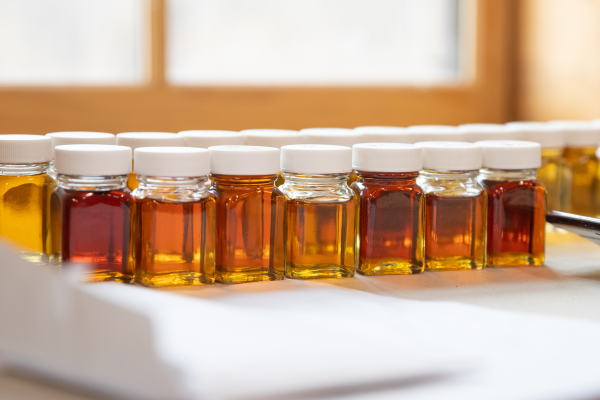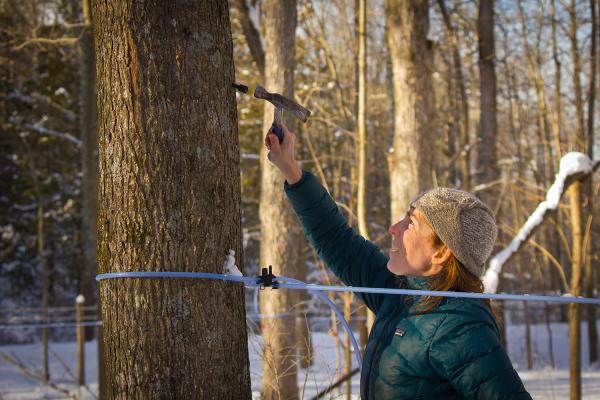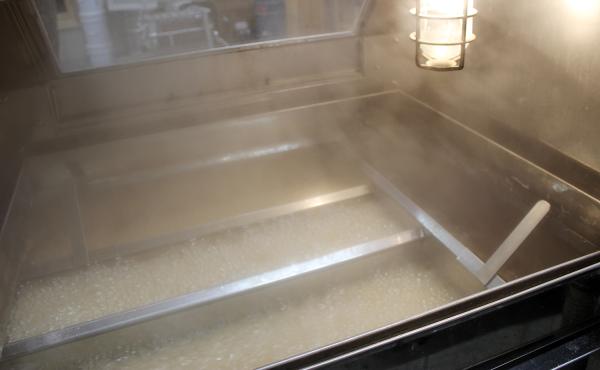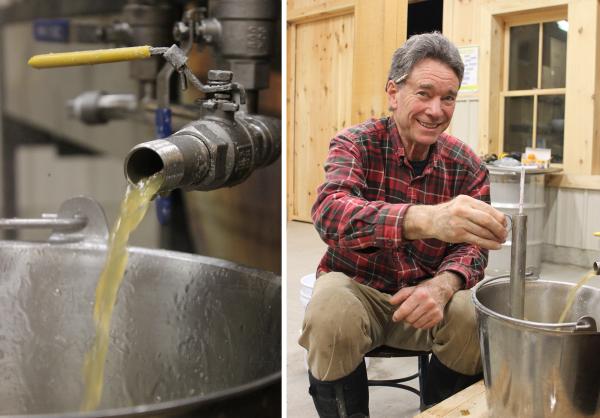I used to do backyard sugaring at my home in Shelburne. One year I had a pint of fully boiled almost colorless syrup-very light golden. It was from early in the season, as I recall. If it had been in the days of cell phones I would have a picture of it.
NOTE: This blog is based on a 2020 interview with Marshall Webb. Marshall passed away unexpectedly last August, but he is always in our thoughts, especially during sugaring season, which he loved.
Most of you probably know that maple syrup comes in different colors, or grades.You may also know that the syrup color changes as the sugaring season progresses: Lighter syrup is usually made when the sap first begins to flow; darker syrup shows up later.
Darker syrup has a stronger flavor than the lighter syrup, but the quality and sugar content is the same. (This is why, in 2014, Vermont changed the grading names. The USDA adopted them a year later). It’s just a matter of taste preference.
But why does early sap make lighter syrup than late-season sap?
We asked Marshall Webb, who’s been sugaring at Shelburne Farms for many years.
“The color of the syrup is determined by two factors: tree physiology and microbes,” he said.
Tree physiology:
As a tree prepares to produce leaves, it converts starch stored in its trunks and roots to sugar, then draws moisture from the ground to help carry those sugars to its branches. As the season warms and its leaf buds swell, the chemistry of the sap changes. By late March or early April in the Champlain Valley, the sap actually gets "smelly and gooey," according to Marshall.
But it turns out, microbes are really where it’s at.
Microbes:
Fresh sugar maple sap is about 2% sucrose; the rest is water. On its way to the sugarhouse, sap picks up microbes that break some of that sucrose down into two simpler sugars: fructose and glucose. (This also happens if the sap sits around in the tank for a while.)
As temperatures warm up over the course of the sugaring season, more microbes tend to show up in the sap, producing more of these simple sugars.
Here’s where it gets interesting. While the sap is being cooked in the evaporator (killing all those microbes!), “nonenzymatic browning reactions” occur that affect syrup color and flavor. It turns out that fructose and glucose get involved in these reactions more than the sucrose, which is more stable.
So more microbes = more simple sugars = darker, more flavorful syrup late in the season!
There’s a great article in Northern Woodlands magazine about all this if you want to know more (it’s where I got most of this information).
But mysteries remain. Case in point: Last year, we made primarily dark syrup, along with some amber. This year, we’ve been sugaring for more than a week and have made over 300 gallons of golden syrup!
When asked about it, Marshall just shrugs and smiles.
So there’s a lot of mystery still to unravel in this deceptively simple business of boiling sap into syrup.
- Here's the list of maple syrup production by state.
- Find out how important maple sugaring is to Vermont's economy.
Comments
Why is my maple syrup cloudy and can I fix that
Hi Robert, Maple syrup can be cloudy due to the formation of sugar sand which, while not harmful and perfectly edible, can give your syrup a rougher texture and sweeter taste. This sediment forms during the boiling of the sap and is usually filtered out. When inadequately filtered or boiled after filtration, sugar sand may be left behind, or form for a second time in the container to produce a cloudy appearance. There's more about this (and how to fix it) here: https://blog.mapletapper.com/tag/why-is-my-syrup-cloudy/
We make 50 gals. of syrup each year, most of it grade A fancy from the first third of the season. The later, dark syrup we use for cooking. The taste of the early syrup is much more refined and far better tasting on pancakes and waffles. The later syrup is better in baked beans or oatmeal.
All of it is good but early is much better.
Hi. Very first time trying this. I tapped five trees and got about 250 Liters of sap. Boiled down I ended up with around 4 Liters of syrup. Very light in color and tastes amazing. A friend gave me a half Liter that is very dark. I think I will keep the dark for baking.
My grandson (9) and I started tapping maple trees in our yard for something to do at the start of the pandemic last March 2020.. Lots of reading and educating ourselves watching video's and trial and error. We learned about the trees the boiling process. Great educational experience for anybody. I had been using Mrs. Butterworth for most of my life. Thick syrup I was trying to make. Tasted great that night but was a big chunk of hard maple candy the next day. Lol. 2 nd batch turned out to watery but still tasted great. After watching more videos the 3rd batch was almost perfect. We did not have a meter to measure the sugar content. It turned out great. Wife got me a brix meter this year for Christmas. Measured the last batch from last year and it was 68% doing it by eye. We are already boiling sap again for this year.
this is my first year making syrup. As my first batch boiled I was sure I was doing something wrong because it was so light. it never got dark and the maple flavor was almost nonexistent. The flavor was almost a sweet nothing. I was sure I did something wrong. Next batch light amber, more pronounced maple flavor, then cold for several days and nights, next batch lighter, next batch darker, cold again for several days, next batch back to yellow, not as light as the first batch but very close and very subtle flavor.
We chopped down a birch tree in March and sap was pouring out of the stump. My son collected a few gallons of sap and reduced it to a couple of cups. It also went from clear to darker amber color.
I have 4 trees with 11 taps. I get about 300 liters of sap a year and general finish 5 to 7 liters per year. It's enough for my family and I use about 1.5 face cord of wood to do it or 25 to 30lbs of propane.
thanks for the info..I've been at it for at least 20 yrs and I learned more from you. I have 24 taps and use propane and wood. Today I overcooked 10 gallons worth of sap. How can I remove the charred debris from my stainless steel pot?
Hi Wayne, Our sugarmaker Dana shared this answer to your question:
Soaking in boiling water might be a good first try. You can use vinegar to clean the pan. Pour in some vinegar and let it sit overnight. Then rinse really well! You might need to do some scrubbing too but don't use anything abrasive, just a rag and elbow grease. We use a plastic putty scraper sometimes too, but don't use anything that will scratch the surface of the stainless steel.
Hope this helps!
Dana
This year was the first time I've seen syrup so dark my buddy told me sugar content was low he has been doing sap for a long time Ive been doing it for a couple years just kinda hobby cook ive learned that dark syrup is for cooking learn more every time I do it thanks everybody this site




